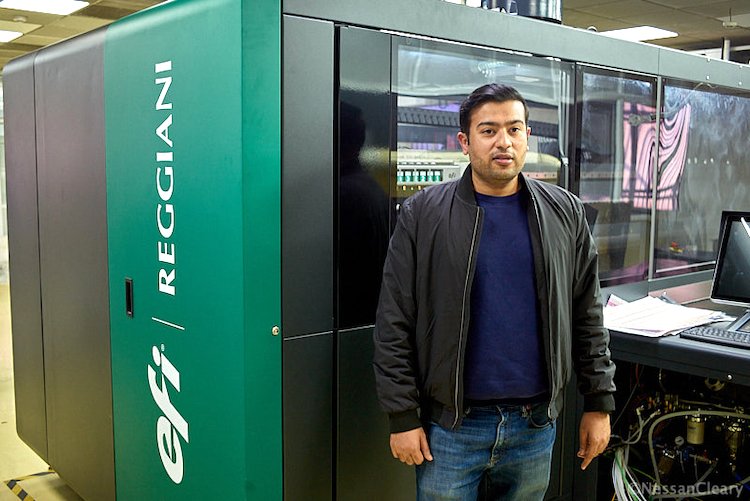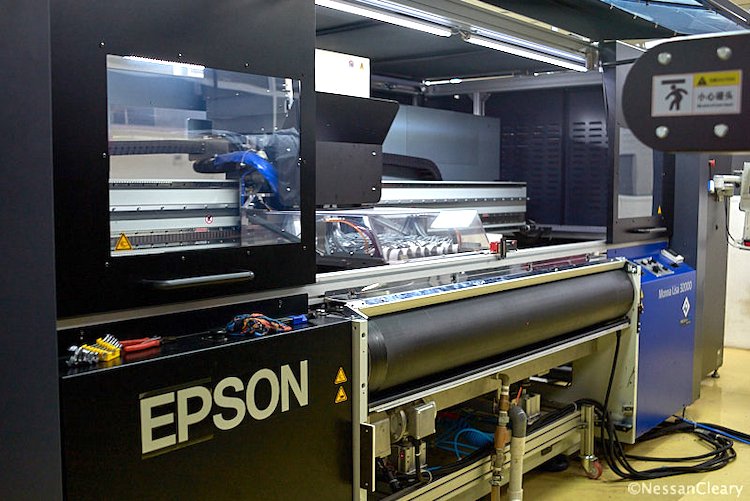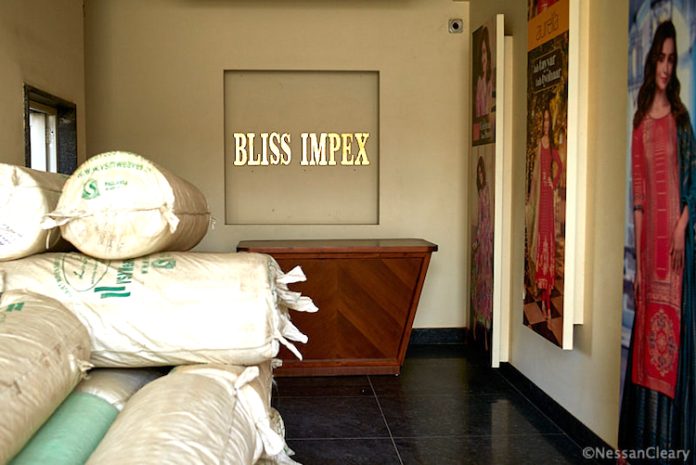One of the most striking things about visiting India is just how colorful everything is – from shopfronts and market stalls to the clothes that people wear out and about.
I wanted to get a better understanding of the Indian textile market and fortunately, Ekansh Jain, the owner of Bliss Impex, was happy to show me around his factory. The Bliss Impex name is already known to readers outside India, thanks to Durst’s marketing department announcing back in 2019 that the company had just bought four Durst Alpha textile printers.
At that time, Jain said that he invested in the four Durst machines in order to expand the company. This has obviously worked as he bought two more printers, one each from Epson and EFI, at the start of this year, both of which were being installed when I was there in February of this year.
It’s certainly an impressive operation to visit with so many large production machines running in parallel lines together on the air-conditioned upper floor of a factory at the end of a road that runs through an industrial estate with factories on both sides in Gurgaon, just south of Delhi. Most of the other businesses in the industrial estate are also involved in the textile industry in one way or another, from supplying raw materials to services such as embroidery. It later transpires that Jain is the fifth generation to run the family business, which was set up by his great-great-grandfather, and that as well as the Bliss Impex factory, he also owns most of the land that makes up the surrounding industrial estate.

Three of the Durst Alpha 190s were set up with reactive inks and are still going strong, side by side. These have a print width of 190cm with a print resolution of up to 600 dpi. Jain was in the process of moving the fourth Durst machine, an Alpha 180, downstairs where it will become the first machine on a new production floor of the same size. This machine prints to transfer paper for dye sublimation to polyester.
Alongside the Alphas, a new Epson Monna Lisa 32000 was installed at the start of the year. This is fitted with 32 of Epson’s PrecisionCore printheads, which can produce up to 697 square meters an hour in a single pass at 300 x 600 dpi, or 423 square meters an hour in two passes at 600 x 600 dpi. It uses Epson’s Reactive Genesta inks. It’s available in 240cm and 340cm widths as well as the 180cm size installed at Bliss Impex.
Right at the end of the line was a brand new 32-head EFI Reggiani Power, for which they were still making the profiles. This can print to fabric at up to 1020 square meters an hour in a single pass at 600 x 300 dpi or up to four passes for 600 x 1200 dpi, which produces 295 square meters an hour. Again, Bliss Impex has opted for the 180cm size though Efi also offers 240 and 340cm widths.
There’s also an Atexco printer from China, which uses a camera for registration of double-sided prints to ensure the prints on the front and back line up. Bliss Impex uses the Atexco to produce a particularly nice effect of printing color on top of a material that’s already been embroidered.
Bliss Impex runs three shifts a day and Jain says that he only buys digital printers from vendors that have local service support. He says, “I always like to have a service team based here. Epson and EFI have their own team here. They will do the profiling and then they will leave one person to make sure that it runs.”
He adds, “Once the heads go, we recycle them. We have an agreement with the European companies so they take care of them. I would rather not run a faulty head but recycle it and get the right quality.”
All of these printers are offered with a choice of inks, but Bliss Impex has opted for 8-color reactive inksets for all of them, apart from the Alpha 180 Dye sublimation machine. Jain explained that he worked with a wide number of different fabric suppliers and so needed to be flexible, saying, “I can’t just stick to certain fabrics.” He says that inevitably some printers are better than others at certain materials, which led him to choose machines from several suppliers, adding, “I wanted to create a showroom where I could have all the latest machines.” The production software is NeoStampa from InEdit, which is now owned by EFI.

Besides the digital machines, Bliss Impex also operates a range of conventional rotary and flatbed textile printing machines, as well as a label printer and also has an export arm. Jain says, “I have really upset the market by dropping the prices right down but the advantage is that I’m not trying to compete with other digital printers. I’m competing with my rotary.”
He continues, “When I first thought of putting these digital printers together people thought I was mad because it’s hard to run one machine let alone several big machines. My thinking was that I never had to compete with the market as I always competed with my own rotary work. I wanted to be in the market for this technology as I thought it was the future.
“And with digital I am putting more work through than with the rotary machines and it’s all on the same floor. It’s clean and hygienic. It’s better working conditions for the employees. It’s all sustainable.”
He says that a lot of people have now moved into digital printing but adds, “I would challenge anyone to find better quality with digital.” For this reason, he is also cautious about the current trend in textile printing towards pigment inks. He says, “I’m still going for reactive. I think that pigment needs more research and needs to be more cost-effective to really compete because it doesn’t have the easy hand feel of the reactive.”
He continues, “I can see a lot of advantage in bringing lower consumption of water but we still need to wait another few years more for pigment to reach the cost and performance of reactive.” He adds, “The pigment ink costs are more than double and the consumption is triple.”
He says that he is already using roughly 35% less water with the digital printers than he would use with a conventional rotary approach – though he points out that both digital and rotary require water to prepare the fabrics. As with most volume producers, Bliss Impex is buying in raw materials, which then have to be put through a ready-for-dyeing process. This typically involves scouring and bleaching the materials and then equalizing them to ensure a consistent print quality.

Photo Nessan Cleary
Naturally, with so many printers, he has considered investing in a single-pass inkjet machine but doesn’t think the print quality is as good. He explains, “The reason I don’t want to use single pass is that with the multi-pass you can increase the colour intensity by increasing the number of passes. But I can’t control this with a single-pass printer.” He adds, “And in my case, I have many other people to look after where I need to satisfy their quality and their color. And with the single pass, I would have to stop the production for the whole line. So I would rather have the multi-pass machines. But I’m still contemplating the single-pass printers.”
Jain says that the Covid pandemic did slow down the company’s growth though the effects of the pandemic are now receding. He says that it changed the world, and left established players with equipment and software that needed to be updated, which is one reason for investing in the new Epson and EFI machines. He adds, “You need the quality. If you don’t have the quality you can’t find the right buyer.”
But he also says that after the pandemic people wanted to use more imaginative materials and were concerned about the environmental issues, particularly around water use. This worked in his favor since he was already using digital printing.
Overall, the company is expanding and has a German partner for exports to Europe. Print quality is key to the business despite also facing the same cost pressures that are common to India. But Jain is relaxed with the air of a man who has little to worry about. And given that he’s preparing a second production floor, there’s every chance that we will be hearing more from Bliss Impex as the company continues to build up its digital production capability.
You can find further details on this company from blissimpex.in.
First published on15th April 2024 in the Printing and Manufacturing Journal. Reprinted by permission. www.nessancleary.co.uk
















